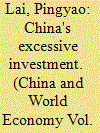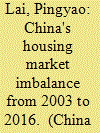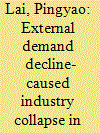|
|
|
Sort Order |
|
|
|
Items / Page
|
|
|
|
|
|
|
| Srl | Item |
| 1 |
ID:
084743


|
|
|
|
|
| Publication |
2008.
|
| Summary/Abstract |
China's economy has witnessed serious excessive investment over the past 5 years, mainly in the infrastructure and real estate. Excessive investment has adverse impacts on both economic growth and macroeconomic stability. The main causes of this excessive investment are inappropriate growth strategies, low interest rates and weak constraints on government investment expenditure. To effectively control excessive investment, China needs to adjust its growth strategy, to speed up the process of interest rate marketization, and reform the existing public expenditure system.
|
|
|
|
|
|
|
|
|
|
|
|
|
|
|
|
| 2 |
ID:
058159


|
|
|
|
|
| Publication |
Nov-Dec 2004.
|
|
|
|
|
|
|
|
|
|
|
|
|
|
|
|
| 3 |
ID:
154449


|
|
|
|
|
| Summary/Abstract |
During 2003–2016, China experienced an unprecedented housing market imbalance. The present paper applies the user cost approach to conduct a systematic analysis of this important phenomenon, examines the policy factors behind the persistent housing market imbalance, and explores policy options to correct the housing market imbalance. We found that during most of 2003–2016, the user cost was significantly lower than 2 percent, caused by high income growth, rapid credit expansion and low interest rates, which led to the persistent housing market imbalance. Therefore, the government should control bank credit and introduce property taxes during the possession of houses.
|
|
|
|
|
|
|
|
|
|
|
|
|
|
|
|
| 4 |
ID:
187798


|
|
|
|
|
| Summary/Abstract |
This paper is a preliminary attempt to use both the value added approach with double deflation and the expenditure approach to deflate China's nominal GDP over 15 years (2004–2018). The results show that China's real GDP growth during the period has significantly more fluctuations than the official statistics indicate. Additionally, inflation, as measured by the official implicit GDP deflator, is generally overestimated during boom years but underestimated during downturn years. In particular, it is shown that China's growth slowdown in recent years before the COVID-19 pandemic may have been more severe than official figures suggest.
|
|
|
|
|
|
|
|
|
|
|
|
|
|
|
|
| 5 |
ID:
125042


|
|
|
|
|
| Publication |
2013.
|
| Summary/Abstract |
China's foreign trade has entered a new stage, marked by some profound changes since 2003. After 5 years' consecutive high growth, China's foreign trade experienced a significant slowdown in growth following the onset of the global financial crisis in 2008. The purpose of this article is to present a review of the development in China's foreign trade over the past 10 years, and to explore important changes that have taken place during this period of time. A major finding of the present paper is that the traditional forces driving the high export growth in China, that is, low-cost labor, low-cost resources and low-cost money, have been disappearing. The policy implication is that over the next 10-15 years, the most important conditions for sustaining high export growth will be promoting the development and export of private enterprises in traditional heavy industries and high-technology industries, and relying on technological progress and high productivity to propel export expansion.
|
|
|
|
|
|
|
|
|
|
|
|
|
|
|
|
| 6 |
ID:
096223


|
|
|
|
|
| Publication |
2010.
|
| Summary/Abstract |
Industry collapse has become an important phenomenon in China's recent economic growth fluctuation. This paper develops a simple model to analyze this phenomenon. Our analysis focuses on an external demand decline-caused industry collapse. The model reveals that the combination of large-scale decline in external demand with a horizontal domestic supply curve causes the domestic export industry to undergo a sharp decrease in output in a short period of time, which further leads to a sharp decline in employment. The conventional stabilization policy is less effective in coping with this sudden industry collapse. The Chinese Government needs to formulate an appropriate structural industry stabilization policy to cope with the sudden industry collapse, and, in particular, to implement a direct employment aid program to deal with unemployment resulting from the industry collapse.
|
|
|
|
|
|
|
|
|
|
|
|
|
|
|
|
| 7 |
ID:
138899


|
|
|
|
|
| Summary/Abstract |
China has witnessed an unprecedented great leap forward in investment since the 2008 global financial crisis, and at the same time real GDP growth has undergone a significant slowdown. This paper examines China's growth slowdown since 2008 up to 2013 using a growth accounting model in a systematic way. It is found that China's growth slowdown since 2008 almost completely comes from a sharp slowdown in total factor productivity growth. During this period, the positive effect on growth from expanding investment has been completely offset by the negative effect of the slowdown in total factor productivity growth. Currently, China's economy has slid into the Solow downward path. Under these circumstances, a soft landing is completely infeasible. Unless the Chinese Government implements substantial rebalancing and comprehensive and in-depth market-oriented reform, accompanied by large-scale de-investment (decreasing in the ratio of investment in GDP) and massive employment adjustment, China will be unable to avoid the Solow downward path, and a hard landing in investment will be inevitable in the near future.
|
|
|
|
|
|
|
|
|
|
|
|
|
|
|
|
|
|
|
|
|